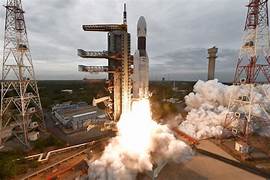GSLV-F16 Successfully Deploys NISAR, a Cutting-Edge Radar Mission to Monitor Earth’s Complex Processes
Published on: July 30, 2025
By: [BTNI]
Location: Sriharikota, India
In a landmark achievement for global space collaboration, the NASA-ISRO Synthetic Aperture Radar (NISAR) satellite was successfully launched onboard the GSLV-F16 rocket from the Satish Dhawan Space Centre (SDSC) in Sriharikota, Andhra Pradesh, on July 30, 2025. This joint venture between the Indian Space Research Organisation (ISRO) and the National Aeronautics and Space Administration (NASA) promises to revolutionize Earth observation by providing unprecedented insights into the planet’s dynamic processes, from ecosystem changes to natural hazards.
A Pioneering Mission for Earth Science
The NISAR satellite, equipped with the first-of-its-kind dual-frequency synthetic aperture radar, is designed to deliver high-resolution data on Earth’s surface, capable of detecting changes as minute as a centimeter. This advanced radar system will systematically map the planet, offering critical information on complex environmental phenomena such as ecosystem disturbances, ice-sheet collapse, sea level rise, groundwater depletion, and natural hazards like earthquakes, tsunamis, and volcanic eruptions. By providing detailed, near-real-time data, NISAR will empower scientists and policymakers to address pressing global challenges with greater precision.
Technical Marvel of the GSLV-F16 Launch
The successful deployment of NISAR via ISRO’s Geosynchronous Satellite Launch Vehicle (GSLV-F16) underscores India’s growing prowess in space technology. Launched from the Second Launch Pad at SDSC, the GSLV-F16 performed flawlessly, placing the satellite into its designated orbit.
The mission marks another milestone for ISRO, which has consistently demonstrated reliability in delivering complex payloads for both national and international partners. The launch was witnessed by scientists, dignitaries, and space enthusiasts, who celebrated this historic moment in India’s space journey.
NASA-ISRO Collaboration: A Global Benchmark
The NISAR mission exemplifies the strong partnership between ISRO and NASA, combining the expertise of both agencies to create a transformative tool for Earth science. NASA contributed the L-band radar, engineering payload, and data systems, while ISRO provided the S-band radar, the spacecraft bus, and the GSLV-F16 launch vehicle. This collaboration not only strengthens Indo-US ties in space exploration but also sets a benchmark for international cooperation in addressing global environmental challenges.
Impact on Science and Society
NISAR’s data will be a game-changer for scientists studying Earth’s surface dynamics. Its ability to monitor changes in forests, wetlands, and agricultural lands will aid in sustainable resource management. The satellite’s observations of ice sheets and glaciers will contribute to understanding climate change impacts, while its mapping of fault lines and volcanic activity will enhance disaster preparedness.
Also read- https://www.btnewsindia.com/group-captain-shubhanshu-shukla-makes-history-with-axiom-mission-4/ https://www.btnewsindia.com/collector-directs-swift-action-on-public-grievances-at-jan-darshan-in-mohla/
Additionally, NISAR’s insights into groundwater levels will support water resource management, particularly in regions facing water scarcity.The mission’s open-data policy ensures that its findings will be accessible to researchers, governments, and organizations worldwide, fostering global collaboration in tackling climate change and natural disasters. For India, NISAR’s data will be particularly valuable in managing its diverse ecosystems, from the Himalayan glaciers to coastal regions, and in strengthening disaster response mechanisms.
A Moment of Pride for India
The successful launch of NISAR has sparked widespread pride across India, with the mission being hailed as a testament to the country’s scientific innovation and global leadership in space technology. ISRO Chairman Dr. S. Somanath congratulated the team, stating, “NISAR is a shining example of what India and the world can achieve through collaboration and innovation. This mission will redefine how we understand and protect our planet.” NASA Administrator Bill Nelson also lauded the launch, calling it “a monumental step in our shared quest to safeguard Earth’s future.”
Looking Ahead
NISAR is expected to operate for a minimum of three years, delivering a wealth of data that will shape environmental and disaster management policies for decades. Its ability to provide consistent, high-resolution imagery regardless of weather conditions or time of day makes it a unique asset in the global effort to monitor and mitigate climate change impacts.
Conclusion: The launch of the NASA-ISRO NISAR satellite from Sriharikota marks a historic milestone in Earth observation and international collaboration. By harnessing cutting-edge radar technology, NISAR will provide critical insights into our planet’s changing landscapes, empowering humanity to address pressing environmental challenges. This mission not only showcases India’s growing stature in space exploration but also reinforces the power of global partnerships in building a sustainable future.




